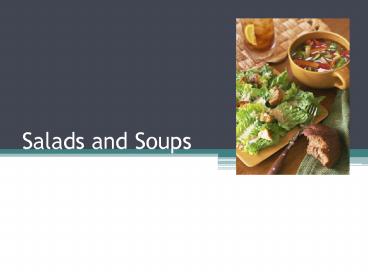Salads and Soups - PowerPoint PPT Presentation
Title:
Salads and Soups
Description:
Salads and Soups Types of Salads Appetizer Accompaniment Main Dish Dessert Nutrients in Salads Vitamins Minerals Fiber Protein Carbohydrates Principles of Salad ... – PowerPoint PPT presentation
Number of Views:172
Avg rating:3.0/5.0
Title: Salads and Soups
1
Salads and Soups
2
Types of Salads
- Appetizer
- Accompaniment
- Main Dish
- Dessert
3
Nutrients in Salads
- Vitamins
- Minerals
- Fiber
- Protein
- Carbohydrates
4
Principles of Salad Making
- Place on a chilled plate
- Prepare salad dressing ahead and chill
- Make just before eating
- Choose fresh and good quality produce
- Salads should look neat, but not labored over
- Handle greens as little as possible
- Avoid too much dressing
- Do not put dressing or salt until just before
serving - Break or tear into bite-sized pieces
- Use no more than 3-4 ingredients
- Ingredients should be well drained
- Combine crisp with soft ingredients for contrasts
in texture - To avoid a smashed appearance, toss with a fork
- Serve immediately
5
Care for Salad Greens
- Crisp up greens by placing in ice water for a few
hours before serving - Drain thoroughly before serving
- Greens may be broken or shredded according to the
purpose - Do not overhandle or greens become bruised and
wilted - Store in a plastic container. Do not wash until
you are ready to use it. - Never freeze
6
Different Kinds of Greens
Iceberg
Romaine
Bibb
Green Leaf
Endive
Chinese Cabbage
7
Types of Soups
- Soups made from stock
- Bouillon
- Consomme
- Soups made from stock and milk or cream
- Bisque
- Chowder
8
Market Forms of Soups
- Canned
- Dried
- Frozen
- Concentrated
9
Food Value of Soups
- Protein
- Vitamins
- Minerals
- Carbohydrates
- Fat
- Food value can be increased by serving other
foods with soup
10
Serving Soups
- Soup dishes should be deep
- Set soup dishes on a plate slightly larger than
the soup dish - A soup spoon is smaller than a tablespoon and
larger than a teaspoon - Bouillon spoons are small round-bowled spoons
- In using a soup spoon, dip the spoon away from
you, take the soup from the side of the spoon
silently - Do not leave spoon in soup dish, place it on the
plate - Never crumble crackers or toast in your soup, but
it is permissible to put two or three crackers on
top of your soup































